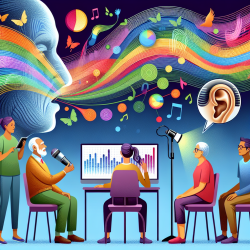Introduction
Understanding emotions in speech is crucial for effective communication, especially in educational settings where practitioners work with diverse age groups. A recent study titled Age-Related Changes in the Perception of Emotions in Speech: Assessing Thresholds of Prosody and Semantics Recognition in Noise for Young and Older Adults sheds light on how different age groups perceive emotions in speech, focusing on prosody (tone) and semantics (words). This blog explores the study's findings and discusses how practitioners can apply these insights to improve their skills and outcomes for children.
Key Findings
- Recognition Thresholds: Young adults have better recognition thresholds for emotions in speech than older adults, indicating an age-related decline in processing efficiency.
- Prosodic Advantage: Across age groups, prosody is more easily recognized than semantics, suggesting that tone plays a more significant role in emotion recognition.
- Selective Attention: Older adults experience more difficulty in focusing on one channel (prosody or semantics) and are more affected by irrelevant information, indicating cognitive challenges in selective attention.
Implications for Practitioners
The study highlights the importance of understanding age-related differences in emotion recognition, which can be pivotal for practitioners working with children and older adults. Here are some practical applications:
- Focus on Prosody: Given the prosodic advantage, practitioners should emphasize tone and vocal cues when communicating emotions, especially in noisy environments.
- Age-Specific Strategies: Tailor communication strategies to the age group of the audience. For younger children, focus on clear and expressive prosody, while for older adults, consider simplifying the auditory environment to reduce cognitive load.
- Enhance Selective Attention: Develop exercises and interventions that improve selective attention, helping older adults better focus on relevant speech channels.
Encouraging Further Research
While the study provides valuable insights, it also opens avenues for further research. Practitioners are encouraged to explore the following:
- Investigate the role of cognitive training in enhancing emotion recognition in older adults.
- Examine the impact of different types of background noise on emotion recognition across age groups.
- Explore the integration of technology, such as speech-to-text tools, to support emotion recognition in challenging auditory environments.
Conclusion
Understanding how different age groups perceive emotions in speech can significantly enhance communication strategies in educational and therapeutic settings. By focusing on prosody, tailoring age-specific strategies, and improving selective attention, practitioners can create more effective communication outcomes. For those interested in delving deeper into the research, please refer to the original study: Age-Related Changes in the Perception of Emotions in Speech: Assessing Thresholds of Prosody and Semantics Recognition in Noise for Young and Older Adults.










